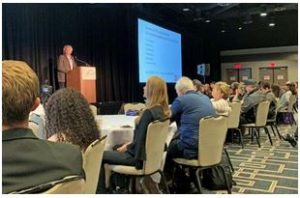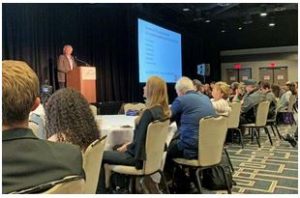Low Back Pain: Facts You Should Know
04/24/2019


Photo compliments of The Spine Research Institute
The prevalence of low back disorders exceeds that of diabetes, COPD, and asthma, according to Dr. William Marras, Ph.D., Honda Chair Professor at The Ohio State University and the Executive Director at the Spine Research Institute. During the keynote presentation at this year’s Applied Ergonomics Conference, he explained that the low back is the most problematic area in the musculoskeletal system and is the most easily injured part of the body.
The low back serves many functions in the body, including structural support, movement, and protection of body organs and tissue. Even with the research that is currently being done in the field, properly diagnosing and treating back pain is often a difficult task.
A few back facts:
- The rate of low back injuries has increased by 17% in the past 30 years, and it is the most disabling condition.
- Medical care and hospital services have grown substantially over the past 20 years, and musculoskeletal disorders (MSDs) directly contribute to those costs.
- A precise diagnosis is unknown in 80 to 90% of patients.
- Only 10 to 15% of cases are diagnosed through imaging. Evaluations tend to be subjective. With no objective evidence, treatment is trial by error.
- A typical golf swing generates 1100 pounds of compressive force in the low back. YIKES!
- Up to 20% of low back disorders are attributable to push and pull overexertions during manual material handling tasks.
- Low back injuries account for $15.1 billion in direct costs per year, and at 1.1 the direct costs, an additional $16.6 billion in indirect costs.
To fix the epidemic, we need to be more aware of the loads and unintentional forces we put on our backs and remove the risk factors that we are exposed to. Marras’ team is hard at work researching methods to do just this. Their motion capture and modelling technology measures risk in the spine during job tasks and rates it using a color-coded system.
We might not have access to their technology, but the use of artificial intelligence and computer vision to conduct MSD risk assessments is now available, is easy to use, and has greater fidelity than traditional observation methods. But, understanding where the high-risk jobs or tasks are is only the first step to reducing risk in the workplace.
These alarming statistics have spurred the onset of many methodologies to improve manual material handling tasks, including exoskeletons, job rotation, and engineering controls.
Exoskeletons are wearable devices that work with the user to augment, reinforce, or restore human performance. They are being used in the workplace to reduce injuries in the entire body, but mostly for the back, shoulder, and hips.
According to Marras, the use of exoskeletons
- for postural assists reduces torso flexion at lower lift origins, but forces at the low back yielded no change.
- to offload the shoulders saw increases in compression up to 52% and A/P shear up to 26%.
- for long-term effectiveness is unknown.
Job rotation is a technique that regularly moves workers between two or more jobs or tasks in an attempt to reduce their risk of developing an MSD. Its primary strategy is to reduce worker exposure to forceful exertions, awkward postures, high frequencies, and vibration in the workplace.
According to Sean Gallagher, Ph.D., Associate Professor in the Department of Industrial and Systems Engineering at Auburn University, “a recent analysis of the effects of job rotation was performed using the LiFFT risk assessment tool, developed by Auburn University. This tool is based on fatigue failure theory, and its measure of estimated cumulative damage has shown strong associations with low back outcomes in epidemiological studies. The analysis looked at performing a job rotation involving a low-risk job, a medium-risk job, and a high-risk job. Results of this analysis showed that rotating workers through these three jobs (as opposed to performing each job individually) led to an overall greater risk for the three workers involved.”
More research on the impact of job rotation strategies on reducing MSDs will be highlighted in the article "The Effectiveness of Job Rotation as a Strategy to Reduce Musculoskeletal Disorders: Belief versus Fact" in the June issue of Occupational Health and Safety.
Engineering controls are implemented to ensure that reaches, forces, and distances of work elements are within acceptable limits of your workforce, which means the workplace is designed to fit the people. By designing for fit, you will design out MSD risk factors altogether. This approach has been proven effective and efficient by many academic studies.
The bottom line: approximately 8 out of 10 Americans will suffer from back pain during their lives. So, since we don’t we see charity runs or auctions to support more research on this disorder, we’d better start preventing it using the methods that are backed by science.






